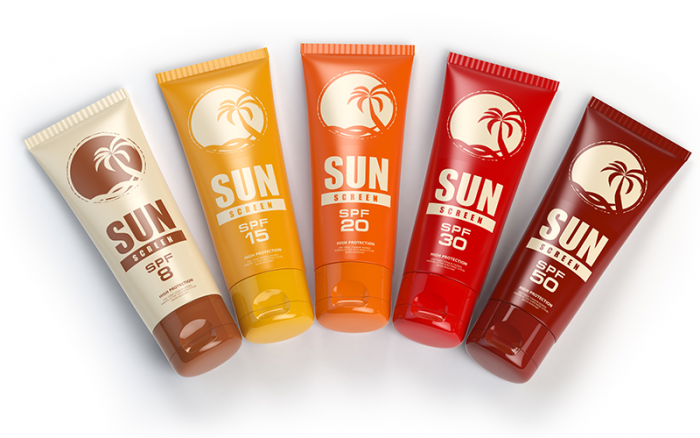When it comes to sunscreens, there’s no shortage of options — and that means it can sometimes be tricky to know which one is right for you. Because sunscreens can differ both in the kind of ingredients used and the degree of protection they offer, it’s important to arm yourself with information on what makes them different and how that might affect you.
One of the most common selling points for sunscreen is its SPF, or sun protection factor, rating. SPF generally ranges from 15 to 50, although these days they can go even higher. The number of SPF indicates the sunscreen’s ability to provide protection from UVB rays.
“There are several reasons we have different levels of SPF offerings when it comes to sunscreen,” says Dr. Gregory Walker, a dermatologist at U.S. Dermatology Partners Waco in Texas. “How much sun protection you need is going to vary depending on your skin type and solar exposure. But it can also be affected by something like taking a medication that makes you more sensitive to the sun, so it’s something you really want to understand.”
Understanding the SPF System
A sunscreen’s SPF is determined by how long it allows you to stay in the sun without burning. But where it can get confusing is that this isn’t a one-size-fits-all equation, so you have to know your skin to be able to decide which one is best for you and how it will protect you.
Let’s say your skin usually burns after about 10 minutes in the sun. Multiplying your SPF times the amount of time it takes to burn — in this case, 10 minutes — gives you the rough estimate of how much time you can spend in the sun. In theory, if you’re using an SPF 15 sunscreen, this would mean you should be able to spend 150 minutes in the sun, or two and a half hours, before needing to reapply.
“You have to be careful if you’re using this equation because there’s a lot of room for error,” Dr. Walker says. “If you’re doing a certain activity in the sun that makes you sweat, or if you’re getting in the water, it’s not going to be as effective as long. And it can also depend on how intense the sun is, which can make it more or less effective.”
Also, the amount of sunscreen the manufacturer recommends using is much more than the average person is going to use, so that can account for very different results, too.
Is Higher SPF Always Better?
It would seem like simply using the highest possible SPF would be an easy answer, but whether or not the products live up to the hype has been a source of debate in recent years. The introduction of ultra-high SPFs has raised questions about their effectiveness at blocking out the sun’s rays.
However, a study published earlier this year in the Journal of the American Academy of Dermatology found that subjects using SPF 50 on one side of their faces and SPF 100 on the other side showed dramatic evidence of the effectiveness of the SPF 100 sunscreen. The side slathered with SPF 50 was 10 times more likely to burn than the side covered in SPF 100, the study cited.
This recent research shows that higher SPF is more effective, but you still have to consider other factors in sun protection. Dr. Walker cautions against letting a high SPF lull you into a false sense of security. Even with a high SPF, you still have to make sure you’re using the right amount and applying it at regular intervals, just as you would a lower SPF rating.
“With a very high SPF sunscreen, you might think you have more protection than you actually do,” Dr. Walker says. “You still need to make sure you’re reapplying it frequently and making sure you’re using liberal amounts. Otherwise, you could be damaging your skin but won’t realize it until it is too late.”
You also have to make sure you are using a broad-spectrum sunscreen, which provides protection from both UVB and harmful UVA rays. Without UVA protection, you’re still risking sun damage.
Finding the Right Sunscreen For You
To find the right sunscreen for you, it’s important to do your homework first. To make sure you’re getting a trusted product, ask your dermatologist or check trusted review sites, such as Consumer Reports and the Environmental Working Group to see how your sunscreen’s SPF has fared in unbiased testing.
You also want to look at what ingredients go into your sunscreen. Steer clear of chemical sunscreens and look for products with zinc oxide. They are the safest and most effective type of sunscreen and are least likely to trigger skin reactions. Specifically, look for a sunscreen that has at least 20% zinc oxide, or 15% zinc oxide with 7.5% titanium dioxide.
The American Academy of Dermatology recommends using sunscreens with SPF 30 or greater, but it also cautions that you can’t simply trust the sunscreen to do its job. It’s still up to you to make sure you’re being responsible about how much sun exposure you’re getting.
“No matter what SPF you’re using, you still need to reapply every couple of hours, and you need to follow the same advice about sun exposure, such as avoiding the sun between 10:00 in the morning and 2:00 in the afternoon, when it’s most powerful,” Dr. Walker adds.
And even though it may seem simpler to grab a spray-on sunscreen, you should avoid them. They don’t provide the even coverage you need and can be dangerous if inhaled. You’re much better off sticking to a lotion.
Additionally, always wear protective clothing, including a wide-brimmed hat and sunglasses, and consider UV-protective clothes that help block out the sun’s rays. Even tightly woven or tightly knitted fabrics don’t keep the sun from reaching your skin, but sun-protective clothing, which carries a UPF (ultraviolet protection factor) rating, are designed specifically to filter out harmful UV rays.
Even after you’ve taken all these precautions, you’ll still want to be particularly careful when you’re around water, snow, and sand since they can all reflect the sun’s rays and intensify its effects.
Looking to Visit a Dermatologist?
To find out more about how to avoid sun damage, or to address damage your skin has already suffered, contact U.S. Dermatology Partners today to make an appointment with one of our board-certified dermatologists. We have multiple locations throughout the country, so fill out our simple online form to get in touch with us. One of our local team members will reach out to you shortly to answer your questions or schedule an appointment for you to visit us soon.
Find a location near me
or


